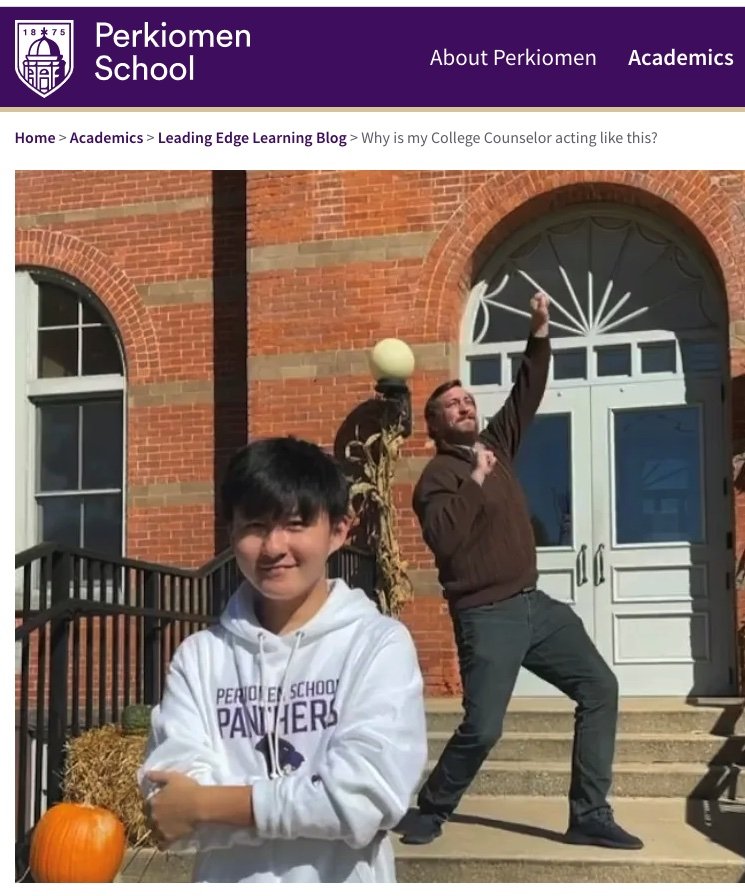How to Take a New Approach to Enrollment Marketing and Send Stats Soaring : Proctor Academy
/Chosen because Proctor Academy saw significant increases in campus visits and applications in one year as a result of new thinking about enrollment marketing. They focused on creating structure and discipline in the nurturing phase of their marketing efforts.
It’s well-known in independent school circles that you don’t want to be the head of school who replaces a beloved one after 20 years of service. It’s a daunting task in any role to follow an icon.
You might say the same about following a director of marketing communications who was a blogging legend. Except in this case, the next person in the position has enjoyed a great deal of success on his own.
End of an Era. Start of a New.
Scott Allenby took over as director of marketing communications at Proctor Academy when Chuck Will, the “first school blogger,” retired last summer. Chuck made a name for himself and for Proctor through “Chuck’s Corner,” which was (and still is) an unbeaten example of authentic branding through storytelling. It attracted 74,000 followers. (You read that right.)
Chuck retired, but hasn’t stopped being a super blogger and marketing expert for independent schools. In fact, we’re honored that he blogs for InspirED.
When Scott came to Proctor in 2006, he didn’t arrive to work in the marcom office. He landed in Andover, NH because he and his wife, Lindsey, wanted to return to the area she grew up and to the school her mother once taught. The couple served as dorm parents and taught, and Scott helped launch Proctor’s athletic department’s social media efforts and web communications in 2008. Scott expanded his role in Proctor’s communications office when he added an academic blog to his plate in 2011 to add additional depth to the school’s blogging efforts by publishing two in-depth blogs a week discussing Proctor’s academic model.
When Chuck retired 2014, Head of School Mike Henriques appointed Scott director of marketing and communications, and Scott wasted no time in shaking things up. His office moved out from under development and now reports directly to the head. This enables him to know what the entire school wants, including admissions, development, and internal audiences. (Previously, admissions handled its own marketing.) The move also allowed for more cross-pollination of content, saving his office time and resources.
First Steps
Scott built an integrated team made up of a full-time graphic designer; one team member who focuses solely on analyzing admissions data and handling admission communication workflow; another team member who guides stewardship opportunities with the development office; a part-time (5-7 hrs a week) photographer (Scott’s wife); and a freelance videographer, who knows the school well and is on campus often.
Another top agenda item was to create an internal structure for Proctor’s marketing and communications. Centered on a marketing plan, it keeps Proctor from reinventing the wheel each year and protects against personnel shifts, while also helping to identify opportunities to leverage content for multiple purposes.
“What we did this year was to be more intentional about our plan,” says Scott. “We needed to take the time to hit ‘pause’ in order to move forward efficiently. It was, and continues to be, time incredibly well spent for our team.” Making time for strategy is critical.
Can You Say “Wow?”
The new structure paid off for enrollment—big time.
1. 57% of those inquiring visited campus (previous five-year average was 42%).
2. 92% of those visiting campus completed applications (previous five-year average was 82%).
3. Increase in applications of 44% over five-year average.
Scott explains, “What the first stat tells us is that 1) people like our website and are intrigued and 2) our email campaign, once an inquiry comes in, is effective in driving people toward the next step in the admissions process that we feel is so critical— getting that face-to-face interaction.”
The second stat tells Scott that digital marketing efforts, in addition to face-to-face efforts by the admissions team and internal community, are working. To lose only 8% of visitors is pretty remarkable. Scott believes this is due in large part to structured email nurturing and personal relationships formed once a family visits campus.
Scott says of the third stat, “While a 44% increase in applications is powerful, I think the first two stats are far more important in terms of our marketing efforts. The applications are just a result of the effectiveness early on in the admissions process.” Proctor also increased yield this year, but not to the same degree as the other percentages.
Proctor was over-enrolled in April and has a waitlist.
How’d Ya Do That?
According to Scott, the school focused on making the admissions process extremely clear, with strong calls to action. Proctor also thought of and addressed parent and student pain points early in the process. (Examples include: “Why is Proctor so informal, like addressing teachers by their first names?” “Is Proctor rigorous enough?” “I don’t want to send my child away to boarding school.”) Not only did this turn negatives into positives, it also helped to pre-qualify families. Finally, Proctor made it very clear that the school wanted each student/family, an intangible quality that has long defined Proctor’s admission process.
Parent Feedback
Prospective parents reported that they knew Proctor well before visiting so that their on-campus conversations could be more elevated and less informational. This helped families and Admissions counselors get to know one another more quickly, and maximize the effectiveness of each family’s visit to campus.
Advice for the Marketing Newbie
Scott’s first year running Proctor’s communication and marketing efforts did not come without its challenges, however, he acknowledges the key is surrounding yourself with people who have skills that complement yours. He also thinks it’s important to get the right people in the room (e.g., head of school, director of admissions, and director of development) when developing a marketing plan. Last, figure out how to get buy-in on marketing from the internal community, particularly faculty who don’t like to think of the school as a business*.
“In conversations with other schools over the past few months,” Scott says, “they are more focused on increasing the size of their admissions funnel, but we focused our marketing efforts on creating real structure and discipline in the nurturing phase of our marketing efforts. This is where we believed we had the biggest opportunity. People already knew Proctor because of the great work Chuck had done over the past two decades, we just had to help create the structure necessary guide them through the admission process.”
If you like this post, you'll love our newsletter, the Daily Jolt. Sign up here.
Related Posts






















![How To Create An Award-Winning [Anniversary] Magazine: Cardigan Mountain School](https://images.squarespace-cdn.com/content/v1/57532abf27d4bd17be970a61/1648569270513-JR73OVUH159CUU8B5CU9/14Cardigan.jpg)












Master Electrician, InspirED School Marketers
Master Electrician isn’t just a fun title for me. It’s how I feel about sparking school marketers to do their best work, connecting them to one another, and helping to make their jobs easier. After working with close to 100 schools in the firm I founded — Turnaround Marketing Communications — I realized that school marketers needed a place where they could find brilliant ideas and brain food and feel supported. InspirED School Marketers was born in 2013 to fill that void, and with the help of my fabulous Best Boy, Rob, we are on a quest to make InspirED a resource you can't live without.
Facebook LinkedIn